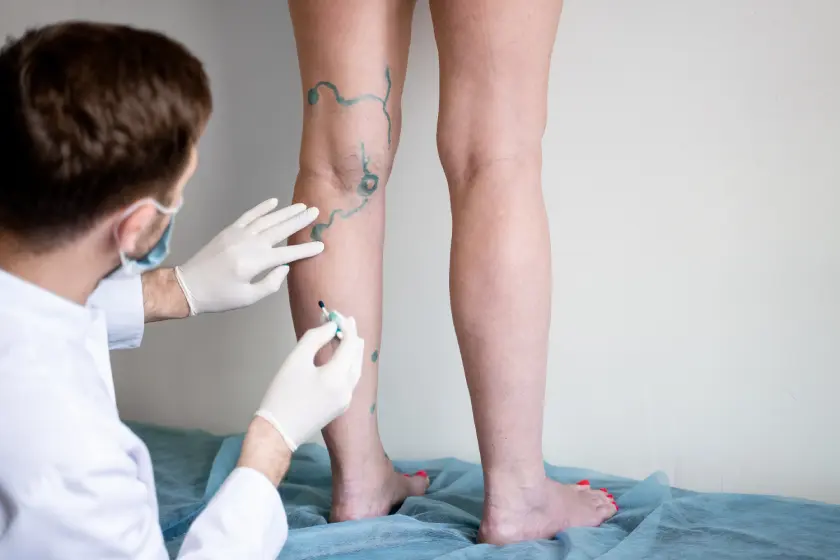
In my years of vascular practice, I have seen many patients who come in with a wound on the leg or foot that simply refuses to heal. Often, these wounds are mistaken for infections or minor injuries, but in reality, they are far more serious. These are arterial ulcers.
An arterial ulcer is a chronic open sore caused by poor blood flow to the lower limbs. It usually develops on the toes, heels, or bony areas of the foot and ankle. When arteries are narrowed or blocked, the oxygen and nutrients necessary for tissue repair cannot reach the affected area. The result is tissue death and ulceration.
Arterial ulcers are commonly associated with peripheral artery disease. They are painful, often dry, and surrounded by thin, shiny skin. Unfortunately, these ulcers are frequently neglected or misdiagnosed, especially in diabetic and elderly patients.
Causes of Arterial Ulcers
The main cause of arterial ulcers is restricted blood flow, but what leads to this blockage? In India, I frequently identify the following conditions in my patients:
Atherosclerosis
This is the buildup of plaque in the arterial walls. It reduces blood supply to the extremities and is the most common underlying factor.
Peripheral Artery Disease (PAD)
A progressive condition that narrows arteries in the legs. PAD is a leading cause of arterial ulcers and a major focus in peripheral artery disease treatment.
Diabetes and High Blood Pressure
These chronic conditions weaken blood vessels and accelerate arterial damage.
Smoking and Tobacco Use
Tobacco constricts blood vessels and damages the inner lining of arteries, severely limiting circulation.
Buerger’s Disease (Thromboangitis Obliterans)
In this condition which exclusively affects young male smokers, there is blockage of smaller arteries and can lead to severe pain or gangrene.
Advanced Age and Sedentary Lifestyle
Older adults and individuals with low mobility have a higher risk of vascular disease and arterial ulcers.
Carotid Artery Disease
Although this condition primarily affects blood flow to the brain, it reflects widespread arterial damage that can also impact the limbs.
Symptoms of Arterial Ulcers
Recognizing the early symptoms of arterial ulcers can help prevent severe complications. I always advise patients to seek prompt vascular evaluation if they notice the following:
- A well-defined wound on the foot or lower leg, often over bony areas
- Pain that worsens when the leg is elevated and improves when dangling
- Pale, cold, or bluish skin around the wound
- Shiny, hairless skin near the ulcer
- Minimal bleeding from the wound
- Delayed healing or no healing at all
- Gangrene or black tissue around the ulcer, if neglected
These symptoms of arterial ulcers are not just surface-level signs. They indicate a deeper circulatory problem that needs urgent vascular attention.
How Arterial Ulcers Are Diagnosed
Accurate diagnosis is essential. In my clinic, we begin with a detailed physical examination followed by vascular assessments to determine the extent of arterial blockage.
Ankle-Brachial Index (ABI)
A simple, non-invasive test comparing blood pressure in the ankle and arm to detect reduced blood flow.
Doppler Ultrasound
This test visualizes blood flow in the arteries and helps identify the exact location of narrowing.
CT Angiography or MR Angiography
Advanced imaging tests to examine blood vessels and plan for intervention.
Blood Tests
To assess diabetes, cholesterol, and inflammatory markers contributing to arterial damage.
Arterial Ulcer Treatment Options
Successful arterial ulcer treatment depends on restoring proper blood flow. Treating only the wound without correcting the vascular problem leads to poor healing.
Here is how we approach it:
- Revascularization
Restoring blood flow is the cornerstone. This can be done through:
-
- Angioplasty – A catheter, followed by a balloon or stent is used to open narrowed arteries and improve circulation.
- Bypass Surgery – In severe cases, we create a new path around the blocked artery using a vein from the patient’s own body. Some may need a synthetic or artificial graft if they do not have suitable vein.
- Wound Ulcer Management
Cleaning, debridement, and dressing of the ulcer under sterile conditions. We use modern wound care techniques that promote healing and prevent infection. The role of vacuum-assisted closure, (VAC) or Negative Pressure Wound Therapy (NPWT) as well as the use of dermal skin substitutes, is increasing, along with the usefulness of hyperbaric Oxygen Therapy (HBOT)
- Medical Management
Controlling diabetes, blood pressure, and cholesterol through medications and lifestyle changes is crucial.
- Arterial Ulcer Pain Management
Pain relief is necessary for patient comfort and mobility. We utilize a combination of local care and medications to enhance blood flow and alleviate pain.
- Lifestyle Modifications
Smoking cessation, exercise programs, and dietary guidance are strongly advised to prevent recurrence.
Advanced Care and Wound Healing
When a patient presents with a complex or non-healing arterial ulcer, advanced wound care may be required. I often use:
- Negative Pressure Wound Therapy (NPWT)
This technology uses vacuum dressing to remove excess fluid and stimulate tissue growth. - Biological Dressings
These are derived from natural materials that support cell regeneration. - Hyperbaric Oxygen Therapy
In select cases, increasing oxygen delivery to tissues can accelerate healing.
Collaboration between vascular surgeons, wound care nurses, and diabetologists is critical for the best outcomes. At our center, we follow a team-based approach to wound ulcer management.
Why Choose Dr. Sumit Kapadia for Arterial Ulcer Care
Arterial ulcers are not just skin wounds. They are signs of advanced vascular disease and require expert care.
With almost 2 decades of experience in vascular and endovascular surgery, I have successfully treated hundreds of patients with arterial ulcers using minimally invasive and advanced surgical techniques. From complex revascularization to modern wound care, my goal is not just to heal the ulcer but prevent future complications.
I offer personalized treatment plans, state-of-the-art diagnostics, and a compassionate approach. Early intervention often saves limbs and, in many cases, lives.
Conclusion
An arterial ulcer is more than a wound. It is a warning sign from your body that your arteries are in trouble. Timely recognition, diagnosis, and vascular intervention can make all the difference. If you or a loved one has a non-healing wound, do not ignore it.
As one of the leading vascular specialists in India, I encourage patients to seek expert care without delay. Proper peripheral artery disease treatment and wound ulcer management can restore mobility, prevent amputation, and improve quality of life.
FAQs
An arterial ulcer is an open sore that develops due to poor blood flow to the lower limbs. It usually appears on the toes or feet and is associated with peripheral artery disease.
The best treatment includes restoring blood circulation through angioplasty or bypass surgery, combined with proper wound care and lifestyle changes.
Cleaning should be done under medical supervision. Debridement, sterile dressing, and topical medications are typically used. Self-cleaning is not recommended due to infection risk.
Arterial ulcers are usually dry with minimal discharge. However, if infected, they may become wet or show signs of pus.
They begin when narrowed or blocked arteries prevent adequate blood from reaching the tissues. Over time, this leads to skin breakdown and ulcer formation.

Dr. Sumit Kapadia
MBBS, MS, MRCS, DNB-Fellow



